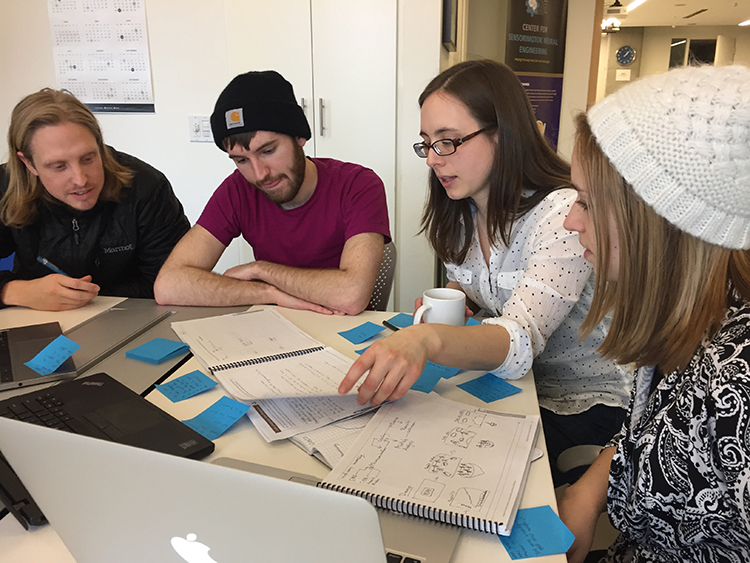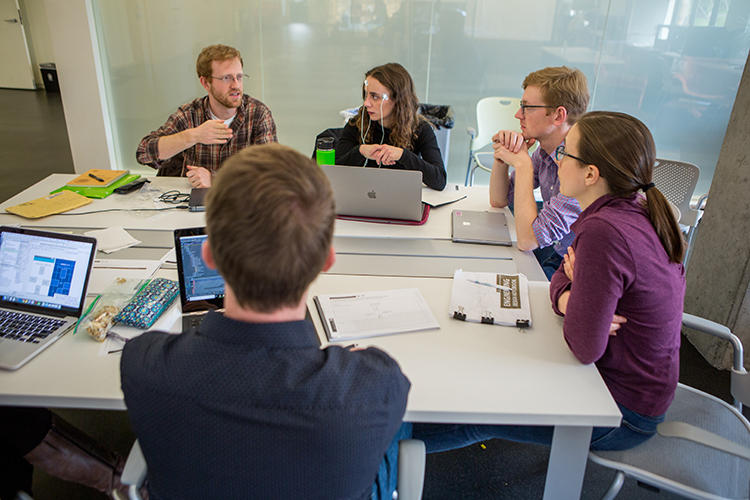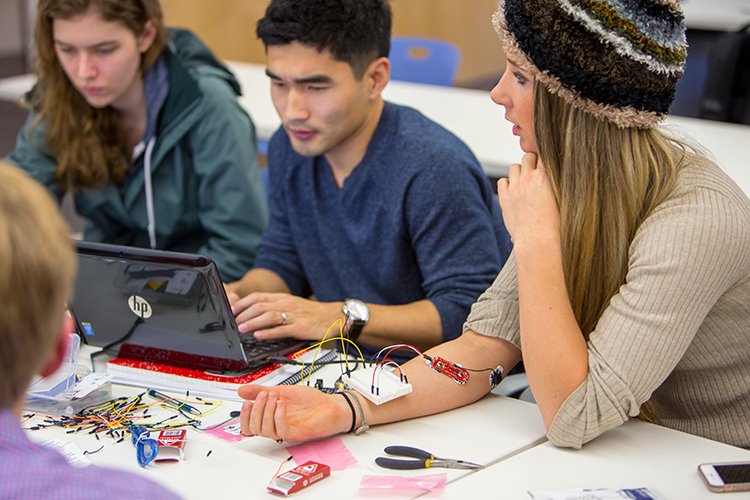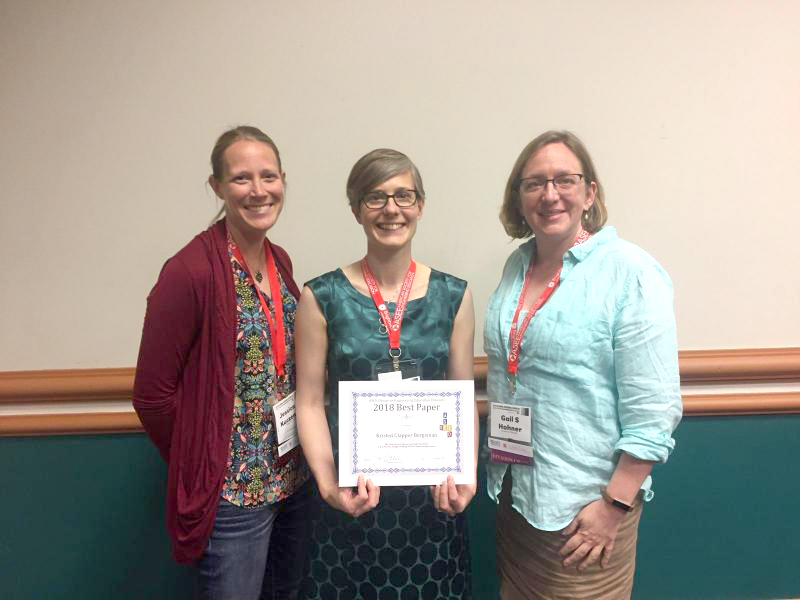New Instructional Tool: The Engineering Design Notebook for engineering design studio courses

The Engineering Design Notebook is an exciting new tool for use in engineering studio design courses—including cornerstone and capstone courses—that provides prompts, exercises, and scaffolds for engaging students in design thinking, the engineering design process, and project planning. The Engineering Design Notebook is available as an open-source educational resource developed by Dr. Lise Johnson and Dr. Kristen Clapper Bergsman and published by the Center for Neurotechnology. This notebook is offered as a tool for instruction, learning, and assessment for engineering design studio courses at the undergraduate level. It is designed for team projects. See below for a scoring rubric, information on the course in which the notebook was piloted, and research findings.
The notebook was first published in 2017 and piloted in an undergraduate engineering design studio course at the University of Washington. Iterations have been implemented to the notebook based on instructor and student feedback and the results of a research study.
If you have questions about this engineering design notebook, please contact Dr. Kristen Bergsman or Dr. Lise Johnson.
Download a free PDF of the notebook (license CC BY-NC-SA 3.0).
Copyright Statement: The Engineering Design Notebook was developed by Lise Johnson and Kristen Clapper Bergsman. Copyright 2017 Center for Neurotechnology (formerly Center for Sensorimotor Neural Engineering).
Use and Adaptations: The notebook is licensed under the Creative Commons Attribution-NonCommercial-ShareAlike 3.0 Unported license. We grant permission for the photocopying, printing, and use of this notebook in non-commercial, educational settings. You may not use this work for commercial or profitable purposes. We grant permission to adapt the work; however if you remix or build upon this work, you must give credit by attributing the original work as specified below, keeping the copyright notice intact, indicate what changes were made without implying that the licensor endorses you or your use, and must distribute the resulting work under the same Creative Commons Attribution license including providing a link to the license. Examples of language for adaptation include “the original work was translated from English to Spanish” or “the original work has been modified by adding pages xxxx.”
Attribution: Engineering Design Notebook. Developers: Lise Johnson and Kristen Clapper Bergsman. Graphic Design and Layout: Clayton DeFrate. First edition published in 2017. Copyright held by the Center for Neurotechnology (formerly Center for Sensorimotor Neural Engineering). If you have questions about this engineering design notebook, please contact Kristen Bergsman, Engineering Education Research Manager at the Center for Neurotechnology or Dr. Lise Johnson.
Scoring Rubric for the Engineering Design Notebook

This scoring rubric was developed by Kristen Clapper Bergsman to guide instructors in assessing students’ work in the Engineering Design Notebook. This scoring rubric is accompanied by a spreadsheet that may be used for recording and calculating student grades on the notebook. We suggest that grading focuses on students’ learning through their engagement in the design process, rather than assessing solely the quality of the designed product. If you have questions about the scoring rubric, please contact Kristen Bergsman.
Engineering Design Notebook Scoring Rubric (PDF)
Engineering Design Notebook Grading Spreadsheet (Excel file)
Neural Tech Studio: An Engineering Design Course

The Engineering Design Notebook was originally designed for use in the Neural Tech Studio, a sandbox-style course at the University of Washington originally developed and instructed by Dr. Lise Johnson. In this popular 10-week course, teams of undergraduate and graduate students are challenged to design, prototype, and present an innovative product that solves a problem within the field of neural engineering. The course progressed through different phases, each with aligned with a section of the Engineering Design Notebook, as described below.
|
Week |
Class Topic and Participant Structures |
Project Stage and Notebook Section |
|---|---|---|
|
1 |
Course introduction, team formation, distribution of notebooks, and initial team design meetings |
Exploring |
|
2 |
Expert Round-Robin activity, reflect on expert feedback in teams, and project selection |
Exploring |
|
3 |
Electrophysiology design principles lecture, team design meetings, first check-in meeting with instructors |
Planning |
|
4 |
Gallery Walk, reflect on peer feedback in teams, team design meetings, team meetings with instructors to check-off project plans and timelines |
Understanding |
|
5 |
Start-up company guest presentation, team design meetings, team check-in meetings with instructors |
Prototyping |
|
6 |
Team design meetings, team check-in meetings with instructors |
Prototyping |
|
7 |
Intellectual property guest presentation, mid-term team presentations |
Prototyping |
|
8 |
Pitch training lecture, team design meetings, team check-in meetings with instructors |
Prototyping and Pitching |
|
9 |
Team reflection meetings |
Reflecting |
|
10 |
Final presentations to judges, awarding of prizes |
Pitching and Reflecting |
Learn more about this exciting course and students’ prize-winning product ideas.
March 2018: UW students compete to invent neural engineering technology with potential for real-world impact
March 2017: Turning student neural engineering projects into viable industry products
Research Findings: Design Thinking in the Engineering Design Notebook

The Engineering Design Notebook was specifically developed to integrate design thinking practices with engineering design. In June 2018, CNT Engineering Education Research Manager Kristen Bergsman won “Best Paper in Division” for the Design in Engineering Education division of the 2018 American Society for Engineering Education (ASEE) conference in Salt Lake City, Utah. Her paper, “The ‘Structured’ Engineering Design Notebook: A New Tool for Design Thinking within a Studio Design Course,” was selected from five finalist papers out of a total of 52 papers accepted into the division. The paper presented Bergsman’s research study of an engineering design notebook that she and CNT University Education Manager, Dr. Lise Johnson, co-created and how the notebook was used by students in Johnson’s 2017 engineering design studio class.
Read the paper: The ‘Structured’ Engineering Design Notebook: A New Tool for Design Thinking within a Studio Design Course
